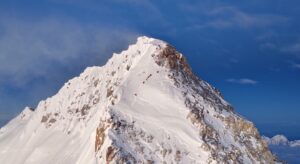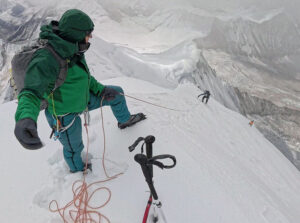Gone are the Japanese and Koreans. This is the era of Indian, Chinese, and Middle Eastern climbers
The number of climbers expected on Everest this spring season will be around 60 percent of a normal year, according to UK guide Kenton Cool. In 2019, by comparison, Nepal issued 381 permits for foreigners and another 140 did Everest via the Tibet side. That’s a lot of boots. This year, the Tibetan side remains closed, at least to non-Chinese teams.
According to their latest (January 17) count, Nepal’s Expedition Operators Association said that 286 foreign climbers have registered for spring Everest, although the final number will grow significantly by the end of March. Teams will then flock immediately to Base Camp or first acclimatize on nearby trekking peaks in April.

Sheikh Nasser bin Hamad Al Khalifa plans to climb Everest this spring, after succeeding on Manaslu last autumn. File image of his arrival in Nepal months ago for the Manaslu expedition: Gulf News
While climbing permits for the 8,000’ers have not yet been issued – so far, only permits for Mera and Lobuche are on the books — Nepal’s embassy in Bahrain has confirmed that a 16-member team led by Crown Prince Sheikh Nasser bin Hamad Al Khalifa will fly to Kathmandu on March 15, bound for Everest.
Twelve members of the Prince’s Royal Guard will join him, as well as three British citizens, the People’s Review reported. Bin Hamad also led the only team that climbed an 8,000m peak in Nepal in 2020: They summited Manaslu in autumn, after acclimatizing on Lobuche.
Middle Eastern climbers have increased in the last few years, and their relatively easy access to vaccines will likely accelerate this trend in the near future. Meanwhile, COVID rates remain high in Europe, and travel restrictions continue in several countries, impacting the number of Westerners able to travel.
“I currently have 23 confirmed members,” Dawa Steven of Asian Trekking told ExplorersWeb. “Nationalities are Indian, Chinese, American, Colombian, Polish, and Greek, and I expect some last-minute additions. My Chinese and Western clients arrive on March 31 so they can go through quarantine.”
Since Indian clients don’t need to quarantine, his will arrive a week to 10 days later. “This year, there will definitely be fewer Europeans and fewer Americans too, because of COVID,” Dawa Steven added.

A rapidly growing market for Everest. Members in the Indian Navy Everest expedition, 2017.
These new trends in nationality go beyond the pandemic. “In terms of the number of climbers, Indians are number 1, Chinese are Number 2, and Americans are number 3,” said Dawa Steven. “This has been the case for a few years now.”
Meanwhile, the number of climbers from Japan and Korea is waning. “Korea is due to high profile accidents in the past which made sponsors shy away from big peaks, while the decreasing number of Japanese climbers reflects social and demographic changes,” the head of Asian Trekking explained. “The golden era of Japanese expeditions has ended. As I understand it, the clubs didn’t foster new talent, and as the previous generation of climbers stopped being able to come, there were no new climbers to take their place.”
Not surprisingly, a significant number of climbers sign on with outfitters from the same countries or similar cultures. Ryan Waters of Mountain Professionals, for instance, told ExplorersWeb that his Everest clients this spring hail from the U.S. and Norway.
In addition to Everest, climbers are also preparing for other 8,000m peaks in Nepal. Seven Summit Treks, the largest outfitter, expects climbers to head to Annapurna and Dhaulagiri on March 15. Some of them will try double-headers on nearby 8,000m peaks.
“We have people for Cho Oyu and Shishapangma as well but no green light from the Chinese Mountaineering Association,” says Thaneswar Guragai of SST. SST has also noticed a decrease in European clients and a corresponding increase in those from China. “We also have some from India, the Middle East (including the Bahraini Everest team), Brazil, the European Union, and Ukraine.”

Determined to increase social media likes, a Taiwanese visitor poses in a bikini at Everest Base Camp.
Considering the truism that Everest Base Camp is a field of millionaires, it is likely that climbers’ nationalities fluctuate with economic trends and a country’s global prestige. What might have been an incomprehensible waste of money just a few years ago may have evolved into a symbol of strength and professional achievement, even prompting the faking of summits, as recently occurred.
Alan Arnette suggests another reason for an uptick in Chinese visitors to Nepal: A previous 8,000m summit is needed to climb Everest from Tibet, he says, so many inexperienced Chinese go to Nepal for a first 8,000m experience before attempting Everest back home.
Finally, the total tally of Everest summits per nationality, as compiled by Fergus White on his High Altitude Expeditions’ blog, shows that after Nepal, the highest numbers of summiters come from the U.S., but India and China are quickly catching up.






